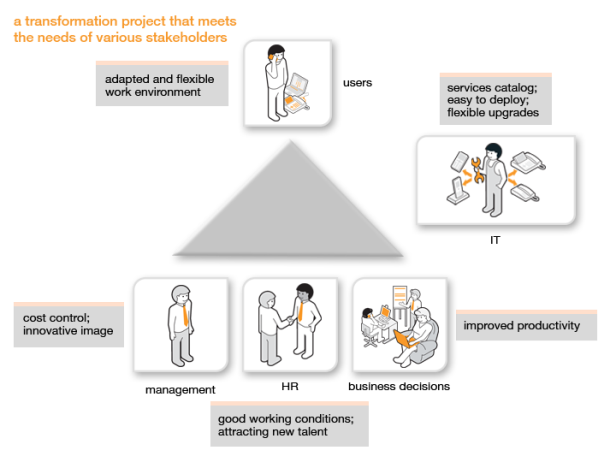How are users adapting to the digital transformation of the workplace driven by new collaboration services? How can businesses ensure this transformation’s success? Can IT departments increase flexibility by placing these tools in the cloud to provide a new variable user environment?
"digital collaboration": the user at the center of a business transformation project
Initiating a transformation of the latest collaboration tools is no longer just a technical project as it was in the days of the private automatic branch exchange (PABX). These are now global and complex projects that have a direct influence on user environments and work.
Users can view this kind of transformation in two ways:
- positively, as the services they use in their private sphere on a daily basis are easy to use and adapt to their environment (instant messaging, click to call, mobility, video, etc)
- more skeptically, since new uses may disrupt certain habits and because not everyone is a tech-savvy millennial
To ensure the success of the transformation, it’s essential to integrate the user aspect as early as possible and understand how these different "user experiences” will be adopted:
above all, it’s the users who determine whether these new services will be successful.
A majority of users want to play a role in the transformation and have control over their work environment.
a collaborative transformation project
This means the project is the perfect opportunity to:
- enable users to take an active role to ensure their change tolerance
- help the IT department play a crucial role in a centralized project that brings together different stakeholders from around the company

analyzing existing tools to plan for the future
A good understanding of the current situation, anticipated impact and stakes is paramount to developing a transformation strategy adapted to each population segment and usage profile:
- what uses does each population segment need? Are there currently competing or complementary users on different tools? How widely will these uses be adopted? How are they perceived? What are the various user and business constraints?
- what uses will be needed in the future? What usage profiles are needed for each different population segment? What shared features can be implemented during and after the transition?
Of course, the various technical and organizational elements can’t be neglected:
- what installation and interaction will be necessary with the work stations and underlying networks and infrastructure?
- are there one or several directories that list all users at the company? How is it maintained, updated, consulted? Is there a unification project?
- what security and service levels are expected?
- what impact will they have on organizations and support processes?
a digital transformation in steps
To initiate a worry-free transformation, you should first outline the initial scope that will serve as a basis for the overall project development: which users or geographic areas? What use(s)?
A scope that’s too broad can generate too much complexity and risk (avoid the “Big Bang” strategy). On the other hand, a scope that’s too restricted can block existing user communities and limit the intended benefits (the first users will be cut off from the rest and new services will provide isolation instead of fluidity).
The goal is to collect enough feedback and spark enough interest to make users want to continue.
A change support system is highly recommended to:
- catalyze new usage adoption by implementing the appropriate communication and training tools
- but also, and above all, provide analysis and collect feedback on user adoption and satisfaction
A successful deployment on the initial scope:
- guarantees the satisfaction of all stakeholders and will allow for expanding the transformation with little effort
- provides a basic transformation platform to expand and reuse with the necessary tweaks for other scopes
However, even with methodological support for the transformation, the project doesn’t end with the deployment of the initially selected service. During the transformation, the catalog of services to be deployed should be updated to meet the rapidly changing needs of users and organizations.
These permanent upgrades generate a high level of complexity for IT departments: the solutions and services they offer need to adapt to these changes quickly.
the cloud: a solution for improving the IT department’s flexibility in managing these transformations?
By their very nature, cloud collaboration services (as-a-Service) provide flexibility.
They offer significant added value across a great number of upgrade categories:
- functional upgrade: "I need to introduce a new type of device that was not originally planned"
> "I have a pre-set user profile that’s compatible with this device, I don’t have to complete a long setup and validation phase"
- technical upgrade: "I have to integrate the software and hardware upgrades for the solution’s various elements"
> "expiration and interfunctionality are overseen by my cloud service provider"
- interfunctionality: "I have to connect an external participant to an internal meeting"
> "the user path for this type of meeting has been validated and is available through my cloud service"
- capacity planning and rapid deployment: "I didn’t expect such enthusiasm for this use or such a large-scale deployment. My service platform isn’t scaled to manage so many conferences and users at once”
> “I no longer need to rely on the target capacity of my resources. I can adapt to new business situations with ease”
- self-provisioning/self-care: "my users want to control the options and organization of their new environment"
> "they now have access to an interface to modify some service options and organize their meetings”
- cost control: "it’s increasingly difficult to estimate investment costs due to the various demands to increase power and upgrade services"
> “I can limit initial capital expenditure investment and subscribe to the service package I need”
The end goal for IT departments is to meet the needs of variable scale transformation projects, while also minimizing risk and maintaining control.
businesses that adopted cloud services are the most enthusiastic
While cloud services have benefited from two-figure growth every year since their inception, according to a recent study by Forbes, businesses that have adopted a high level of cloud collaboration services say that these services:
- ensure a flexible work environment (94%)
- represent a radical, even ground-breaking, innovation (93%)
- enable the development of new products and services (90%)
- reduce operating expenses (86%)
Without a doubt, "over the years to come the cloud will serve as a catalyst and accelerator for collaboration services" (Forrester).
Franck Lamalle
This post was originally published in French here.
photo: © Beboy - Fotolia.com

As a manager in Orange Consulting, the consulting entity of Orange Business, I am in charge of a team of consultants helping our customers manage their digital transformation projects. I have more than 15 years experience in network and infrastructure services, unified communications, IP Telephony and videoconferencing in multiple delivery modes (integrated, managed or cloud). I aim to keep customer and user satisfaction by always providing advice with a spirit of pragmatism and innovation.